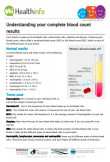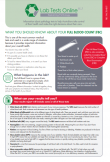Full blood count (FBC) – in-depth information
Also known as complete blood count (CBC), full blood picture or full blood examination
Key points about full blood count (in-depth)
- A full blood count (FBC) is a common test that provides important information about the 3 main types of cells in your blood.
- Red blood cells help carry oxygen in your blood to other parts of your body; white blood cells fight infection; and platelets help your blood clot.
- A full blood count is used to check your general health and to help diagnose and monitor a variety of conditions and treatments.

An FBC is a commonly ordered blood test needing a blood sample to be taken from a vein in your arm and collected in a tube. This tube is sent to the laboratory for analysis.
Results of an FBC give information about the 3 main types of cells contained in your blood:
- Red blood cells – containing haemoglobin that helps carry oxygen in your blood to other parts of your body.
- White blood cells – there are different types of white blood cells, that each work in a different way to help to fight infection. The cells types are neutrophils, lymphocytes, monocytes, eosinophils, and basophils.
- Platelets – these are blood cells that help your blood clot, eg, after you are injured.
The FBC test is important for diagnosing conditions where the number of blood cells is abnormally high or abnormally low. The results show the number of each of the 3 types of cells in your blood along with a reference range to determine if the level is low, normal, or high. It may also note if any of the cells are abnormal in size or shape.
Reference ranges
Reference ranges provide upper and lower limit values. These values or intervals are regarded as normal ranges or limits. They are calculated based on the population being tested and the equipment used to do the test. Reference ranges are therefore determined by each medical testing laboratory and may vary from laboratory to laboratory. This means you need to interpret your results with your healthcare provider using the values provided by the testing laboratory.
Red blood cells
There are a few ways of counting the red blood cells in an FBC, including haemoglobin, haematocrit and red blood cell counts. The haemoglobin value is usually taken as the most important in most situations.
In some uncommon types of anaemia your doctor or nurse may request a reticulocyte count which helps find out if your body is making new red blood cells.
The test may also show if you have any red blood cells that have an abnormal size or shape. The mean cell volume (MCV) is the size of the cells.
White blood cells
Some FBC tests also show what is called a “white blood cell differential”. The word differential in this case means making a distinction, so all the different types of white blood cells and their values are shown. The cells types are neutrophils, lymphocytes, monocytes, eosinophils and basophils. Increased numbers of particular white blood cells can help pinpoint whether an infection is caused by a bacteria or virus. Some types of blood cancer cause lots of one type of white blood cell to be made, meaning the other cell types can’t be made properly. The test may also show if you have any white blood cells that have an abnormal appearance.
Platelets
The platelet count is just 1 value. It may also show if the platelets have an abnormal appearance.
If you are healthy, without any symptoms, an FBC is not usually necessary as part of a routine check-up. An FBC is normally used to help with the diagnosis and monitoring of different conditions and treatments. An FBC can be used to:
- diagnose anaemia and help determine the cause such as iron deficiency anaemia
- help diagnose infection, often along with a CRP test
- help diagnose certain blood disorders, eg, thalassaemia, bone marrow problems, and leukaemia
- help diagnose certain immune system problems
- monitor the response to some types of medication or radiation treatment
- help investigate abnormal bleeding or clotting
- help make sure that any planned major surgery will be safe.
You do not need to do anything to prepare before having this test.
A blood sample is taken by a needle placed in a vein in your arm. An elastic band is wrapped around your upper arm. It may feel tight for a few seconds. You may feel nothing at all from the needle, or you may feel a small brief sting or pinch. The blood sample is collected in a tube, which is sent to the laboratory for analysis. Read more about blood tests.
Interpreting blood test results is not always easy and is best done in consultation with your healthcare team. They will know what is normal for you and how these results tie in with your overall health.
If there is a mild abnormality, all that may be needed is to repeat the test in 1–2 months. This is because many changes can be temporary and your results can return to normal without anything having to be done.
On their own, FBC test results cannot usually provide a certain diagnosis of a condition. However, they can provide important clues about possible problems with your health.
- Low haemoglobin indicates anaemia, which has a large number of possible causes. These include iron deficiency, excessive bleeding or excessive alcohol intake, bone marrow disorders, thyroid disorders, kidney disorders, B12 or folate deficiency, and certain genetic conditions like thalassaemia. The list of possible causes can be narrowed down by looking at other test results like the size of the cells or the mean cell volume (MCV). For example in iron deficiency the MCV is usually low, along with a low ferritin level. Ferritin tests are not part of the FBC.
- High haemoglobin may be caused by underlying lung or heart disease, smoking or problems with your bone marrow.
- A low white blood cell count may be genetic (run in families) and not important. However, it could also be caused by problems with your bone marrow, immune system or certain infections.
- A high white blood cell count usually indicates there is an infection somewhere in your body. However, rarely, it can be a sign of more serious illness like leukaemia. It can also be genetic – it can run in families.
- A low platelet count may be caused by a viral infection or an autoimmune condition (where your immune system attacks healthy tissue).
- A high platelet count may be caused by inflammatory conditions, infection or a problem with your bone marrow.
The following is further reading that gives you more information on having a blood test and the full blood count test. Be aware that websites from other countries may contain information that differs from New Zealand recommendations.
Blood test safety information(external link)(external link) Labtests NZ
Full blood count and blood smear(external link)(external link) Patient Info, UK
Full blood count(external link)(external link) Lab tests online, Australasian Association of Clinical Biochemists
Resources
Understanding your complete blood count results(external link) Healthinfo Canterbury NZ, 2022
What you should know about your full blood count(external link) Lab Tests Online AU
Brochures
Credits: Healthify editorial team. Healthify is brought to you by Health Navigator Charitable Trust.
Reviewed by: Dr Jeremy Steinberg, FRNZCGP
Last reviewed:
Page last updated:







